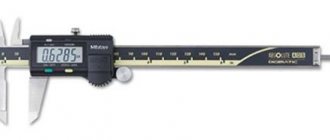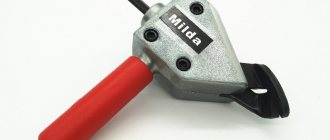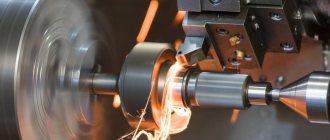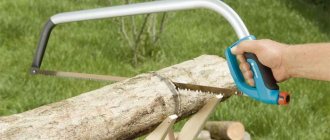Precision is paramount | 05.12.2019
Calipers are a fairly rare type of measuring instrument that can be used to measure the external dimensions of parts or objects. The need for it appeared from the middle of the 19th century. It was then, as it turned out, that the more familiar calipers turned out to be inconvenient for external measurements of product dimensions. By the way, in English-language literature, calipers are still called outside calipers - “external calipers”.
Specifications
The tool is made of steel with hardened marking surfaces and is characterized by the following technical parameters:
- measurement range, mm;
- division price, mm;
- error, mm.
Tool sizes are determined by their length: 100 mm, 125 mm, 175 mm, 200 mm, 250 mm, 300 mm, 400 mm, 500 mm, 600 mm, 700 mm, 800 mm, 1000 mm.
An example of a classic drawing and measuring caliper
Let's look at the features of this tool using the example of calipers brand KTs-300. This device is designed for measuring (internal and external) and drawing circles of various diameters. The device consists of:
- Two hardened tips.
- Rivets.
- Hinge.
- Pencil holder.
It is 30 centimeters long. Measuring range – 450 millimeters. The device provides high accuracy in determining the dimensions of parts, in strict accordance with existing standards and technical documentation.
The device is quite easy to use, hardened legs allow you to firmly fix the device, and has a high degree of accuracy of measurements. The tool is made of corrosion-resistant steel.
Large drawing caliper
It consists of two smooth metal legs with needles, the angle between which is fixed with a special screw. Designed for marking by applying notches and allows you to do without applying a ruler.
Often used for cutting grooves, tenons and marking wooden boards into equal elements. The needles are fixed at the tips using screw clamps.
If necessary, one needle can be replaced with a stylus and you can get a regular compass for drawing circles.
How to use?
If the instrument is used for two-stage measurement, then first spread the legs to the required distance, then firmly apply them with their measuring pads to the external overall dimension, bring the clamping legs together with a screw, carefully remove the calipers and apply the legs to a ruler or other measuring device. In this case, the accuracy of the reading is determined only by the accuracy of the scale. This is acceptable for rough everyday measurements, the tolerance for which can be ±0.5 mm or higher.
Manufacturers of more precise instruments equip them with Vernier scales. In this case, the user must first read the value on a fixed scale, and then on a more precise scale, which will give a measurement accurate to two decimal places - almost the same as a caliper.
When grasping an object with the legs, it is important to position them as accurately as possible on the surface. The front end of each leg has a polished grip, with which they try to cover the longest possible area of the arc (for a circle) or line (for a flat surface). Therefore, a more accurate measurement will be obtained if the legs are not applied perpendicular to the axis of the product being measured, but at an angle of 30...45°.
The accuracy of the reading depends on the condition of the calipers. The legs should be straight and move in the same plane, without intersecting one another. External meters are kept clean and well lubricated. To do this, put the tool in its case between uses.
Models by functionality
Depending on their purpose, instruments are divided into external and internal, as well as measuring, drawing, medical and makeup tools.
Digital calipers - is it worth paying for convenience?
Many modern models are equipped with a digital LCD display, which eliminates the need for a ruler.
However, it should be taken into account that a digital device is less durable, requires a battery and does not always work in cold weather. And if young workers are more comfortable reading data from the screen, many experienced craftsmen prefer to work the old fashioned way.
There is no universal solution; everyone must choose the option that is closest to them.
For external measurements
With its help, external linear measurements of the parameters of any parts are made by comparison. Outwardly it looks like two curved legs connected by a hinge. The measured value is determined using a scale bar.
For outside measurements with screw
The instrument has a more complex structure compared to the previous one; the movement and fixation of the legs is carried out using a screw mounted on a horizontal metal axis.
Serves for external measurements of volumetric objects.
Bore gauge for internal measurements with screw
One of the types of tools for internal measurements that can be used to determine the size; interval; the width of the wall, ledge or step of the part. Convenient to use in hard-to-reach places.
Consists of two steel legs with outwardly curved jaws. The measurement is carried out by spreading the legs until the lips touch the edges of the part. The locking screw fixes this position, after which the size is determined by a measuring ruler.
Bore gauge for internal markings and measurements
It measures the internal linear parameters of objects and compares them with dimensions using a ruler or gauge.
The necessary markings are also carried out according to the specified parameters.
Marker for direct marking
A marking compass is necessary to apply markings to any part or workpiece. Consists of two legs with sharp tips, connected to each other by a bushing or spring.
Marker with screw for direct marking
Helps to transfer specified dimensions from a ruler to a part or workpiece; it can also be used for drawing arcs, circles and markings. Fixation is done using a screw.
Marker with arc for straight marking
Used for direct marking of any objects.
It is equipped with a metal arc, which is fixed with a screw, and serves to prevent accidental opening of the legs during marking.
Measuring
They are used to perform various turning and metalworking works. In addition, they are often used by blacksmiths and coopers. With its help, you can get ahead of whether the part is actually made in the desired shape. For this purpose, it is necessary to measure the diameter at two points. If the device rotates freely around the entire perimeter of the circle (there are no gaps and there is no need to squeeze the legs), then the circle has an ideal shape. In addition, such calipers are used to determine the internal dimensions of the workpiece. For example, you can find out the width of the grooves. Another use of the device is to compare the dimensions of objects. Having taken measurements of the reference part, you can compare the obtained values with the dimensions of other workpieces, which significantly speeds up the work. The main advantage of such devices is their small measurement error. Such models can be of two types. They differ in the shape of the tips of the legs. If the outer side of the tips has a flat sharpening, then such devices are used to determine the internal dimensions. External dimensions are measured with tools that have a flat surface on the inside.
DIY calipers
Sometimes it becomes necessary to design a tool yourself. This is quite simple to do, you just need to stock up on suitable materials and show a little plumbing skills.
For production you need:
- stainless steel sheet (1.5 mm);
- medium-fine sandpaper;
- some hardware;
- locksmith kit;
- lathe;
- anvil.
Make a template for the caliper leg from thick paper, transfer it to the workpiece and cut it out using a grinder. Cut out the inner radius using a small piece of a cutting disc.
Use a file to achieve the desired finishing quality. Drill holes for the hinge, select an M6 bolt of the appropriate length, and install it in place.
This way you will get a fully functional mechanism in which you can easily adjust the force of movement of the legs.
Video on how to make a digital caliper yourself
To work you will need:
- Digital caliper;
- Soldering iron;
- Solder;
- Copper rod;
- Good mood)
Purpose and use
The main task of the device is to determine the dimensions of parts and parts of various objects:
- heights;
- length;
- width;
- thickness;
- diameter
This is necessary primarily in order to compare the obtained values with the reference ones. The device is very often used in conjunction with a caliper and a ruler. This is necessary to measure:
- external linear dimensions;
- walls of complex parts with protrusions;
- intervals;
- jumpers;
- steps.
The device is also used:
- when marking workpieces;
- when roughly measuring the diameters of various parts during rough turning on a lathe.
When performing linear measurements, you should spread the legs of the instrument to the desired state. Then they are brought together until they touch the walls of the object that needs to be measured. Next, using a ruler, you need to determine the distance between the ends of the device’s legs. When making markings, the length of the solution is set using a caliper or ruler.
What do we know from history
The instrument appeared several thousand years ago, as evidenced by the perfect circles on the remains of ancient structures. During research in France, an almost exact iron copy of a modern compass was discovered in the mounds of ancient Gauls.
Archaeologists working on the excavations of Pompeii have found a more complex tool with a similar purpose.
It is curious that calipers have remained virtually unchanged since the times of Ancient Rome. And if you do not take into account modern digital modifications, it still consists of two metal legs and a micrometric screw for fixation.
Description
A caliper is a measuring device with two arched legs, the distance between which is set by a small nut or micrometer screw. Its legs are placed on the same plane and can rotate around its axis. The main difference from a regular compass is the absence of graphic elements on the legs. However, it should be noted that sometimes there are models with a pencil holder. The tool is usually made from structural steel, the legs are hardened. According to GOST, the hardness of the measuring surfaces must be at least 51.5 HRC.
Making a simple caliper
What do we know from the history of the chronicle? The compass, known to us from school, is used to draw perfectly regular circles. The history of this instrument goes back thousands of years, as can be judged by the perfectly precise circles that archaeologists see on the surfaces of ancient structures. During excavations of the burial mounds of the ancient Gauls in France, an ordinary compass made of iron was found. And during the excavations of Pompeii, scientists were surprised to discover a slightly different tool; it had approximately the same purpose, but was very, very complicated.
As it turned out, it has changed little since the times of the Roman Empire; it is produced and used in the same form in the modern world, although now there is even a digital caliper. This term is of foreign origin and consists of the German word “krone” - crown and the Latin “circulus” - circle. Belongs to the category of drawing and measuring instruments. It has two legs, most often arched, between which you can set the desired angle using a micrometer screw, which is also included in the design of the instrument. The screw serves to allow you to adjust the desired distance between the legs. There is also a simplified version.
In the photo - for measuring the outer diameters and dimensions of parts.
Today, such a device is used in production to measure the outer diameters and dimensions of parts (one category of tools), as well as to determine the dimensions of the internal diameters of parts (other models of devices). In medicine, this instrument is also widely used in a variety of industries, but all its varieties are associated with microscopic elements, for example, in dentistry or neurosurgery.
According to the method of obtaining data, mechanical and electronic models are distinguished.
This instrument, as a measuring device, does not need verification, because it is not included in the state register. To compare the dimensions of parts of an object with standard dimensions, this type of caliper is used. So, having measured a part using such a specific method, the data obtained is compared with the data of the samples, from which conclusions are drawn.
Calipers are also very convenient in turning, especially for woodworkers - indeed, when turning decorative parts made of wood, exact dimensions are often not very important and a tool that allows you to quickly, on the go, estimate the size of a part or workpiece is popular. Calipers are especially convenient when turning identical parts, and every turner faces such a task regularly. Having several of these tools greatly speeds things up - you can pre-set them to the main dimensions of the part and not be distracted by measuring with a ruler or caliper.
Very often, calipers are also used in glassblowing.
A simple caliper, like the one in the photo above, is not difficult to make yourself. You just have to choose the right material, then a little simple plumbing work.
In the drawing, calipers with a measuring diameter of up to 180 mm.
What was used in the work.
Tool.
A set of ordinary plumbing tools, something for drilling holes. I used a simple sanding drum installed in a wood lathe. I used a small angle grinder with a thin cutting disc and an electric sharpener. Stamps with numbers came in handy. You can't do without a steel plate or anvil.
Materials.
A piece of sheet steel of suitable thickness. I used stainless steel, 1.5 mm thick. It is desirable that the workpiece is smooth and without dents. Medium coarse sandpaper. A few hardware items.
So.
During the manufacture of the tool, several deviations from the drawing were made - the legs of the calipers were assumed to be of the same thickness, and instead of a rivet, a regular M6 screw was used. Practice has shown that two reinforced “body” washers and a stop washer allow the legs to move smoothly, with little effort. The tightening force of the nut can be adjusted.
I printed out the drawing of the caliper leg on a printer on thick paper, adjusting the size to the required size. After cutting it out, I got a template. The outline of the leg can be transferred to the workpiece using carbon paper.
Everything possible was cut off with a grinder. The difficulty is cutting out the inner radius. It had to be cut out with a very small “remnant” of a cutting disc.
After rough cutting, I finished the outline on a sharpener and then with a magic file.
Here, again, there is an issue with the inner radius. I solved it by making a small sanding drum from a birch log for a wood lathe. The radius is slightly less than the inner radius of the caliper leg. Without removing it from the machine, I wrapped sanding paper around the block and secured the ends with adhesive tape.
After the legs' shape was completely finalized, holes for the hinge were drilled.
An M6 bolt of suitable length was selected, the legs were fastened with an improvised hinge. It turned out to be simple and quite functional; moreover, the force with which the legs move can be adjusted.
We can recommend an alternative manufacturing option, more, hmm, classic - without dancing with an angle grinder. A series of holes with a diameter of 4...5 mm are drilled along the contour of the legs. Use a small chisel to cut jumpers between the holes. The same goes on.
The hardening of the working part of the legs has been omitted and when using the tool not only for pieces of wood, it would be better to do it:
- heat the working parts of the legs to a length of 20 mm to a light cherry-red heat and cool through a layer of oil in water;
- straighten the legs of the caliper after hardening and clean them with abrasive sandpaper.
Some changes can be made to the described sequence of caliper manufacturing.
If the blanks for the legs are small and it is inconvenient to mark them geometrically, then to mark them, two templates are made from thin sheet steel: one for drawing lines on which the centers for the auxiliary holes will need to be marked, and the second (smaller) for marking the contour of the leg . Previously, a template is applied, which is an outline. First, auxiliary lines are applied on the workpiece according to the first template, and then the main lines are applied according to the second template of smaller sizes. The latter is installed so that its contour lines are equidistant from the applied auxiliary contour lines for the centers of the auxiliary holes.
If the material for the caliper blank is strips of 25X4 or 30X4 mm, then straight lines are marked on them, reproducing the shape and length of the legs in an unbent form. Then the strip is cut off with a chisel on a plate or in a vice, retreating 0.5-1 mm from the marking line, and filed rough. After this, the leg is heated and bent with hammer blows on a round mandrel, the dimensions of which correspond to the bending radius of the legs.
The final processing of the calipers does not differ from the sequence given above.
With this method of manufacturing calipers, less time is spent, since there is no need to drill auxiliary holes along the contour of the workpiece. The latter method is used most often in the manufacture of a bore gauge, since bending the ends of its legs is very simple, while bending the legs of a caliper is a rather complex operation, requiring certain skills.
Caliper testing and technical requirements for it. The test of a caliper consists of spreading and squeezing its legs. In this case, the movement in the hinge should be smooth, and the ends of the legs should meet tightly. The surfaces of the caliper must be clean, without scratches, nicks or dents, and sharp edges must be dull. The ends of the caliper legs must be hardened to a length of 20 mm to a hardness of HRC 40-50.
It remains to be said that the tool in the arsenal of a woodworker is in great demand. Practice has shown that it is better to have several pieces. I used a maximum of four at the same time.
In the vast majority of cases, however, one or two are sufficient. To avoid confusion when using several tools, you can stamp a serial number on the legs.
The usual use is to measure workpiece diameters when turning identical parts. At the same time, a sample part is machined, focusing on the required connecting or overall dimensions, the rest will be dictated by the heart. All the following parts are turned to their dimensions - with the help of several callipers, the main dimensions are “removed”, usually one or two diameters and lengths. In this case, it is better to increase the diameters by a millimeter - allowance for grinding. All. Turning these turns into pure pleasure.
The workpiece is machined until the caliper with the largest diameter begins to fail. You can measure directly on a rotating workpiece, while the legs of the caliper should be applied to the workpiece at the same time. Otherwise, the tool may be torn out of your hands.
Babay Mazay, 2016











